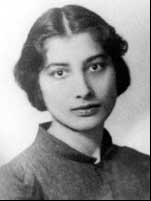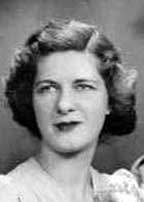British SOE Agents executed at DachauOn the south wall of the crematorium at the former Dachau concentration camp, right next to one of the ovens, hangs a plaque honoring four British SOE agents: Noor Inayat Khan, Yolanda Beekman, Elaine Plewman, and Madeleine Damerment. 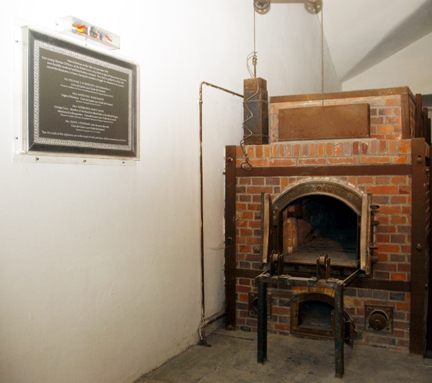 The wording on the plaque, honoring the SOE agents, reads as follows: 1944, four young woman officers of the British forces attached to Special Operations Branch were brutally murdered and their bodies cremated. They died as gallantly as they had served the Resistance in France during the common struggle for freedom from tyranny. This recognition was a long time coming. For 20 years after the war, there was no memorial for those who died at Dachau. Then, on May 9, 1965, a large Museum opened in the former Dachau concentration camp on the initiative of, and according to, the plans of the Comité International de Dachau, an organization of former prisoners. In 1978, a catalog was published by the Comité International de Dachau in Brussels for sale to visitors to the Museum; it contained photos of the exhibits including photos of documents on display in the Museum. But nowhere in the Museum, nor in the catalog, was there any documentation about the four women of the British Special Operations Executive (SOE) who were "brutally murdered" at Dachau on the 12th of September 1944. Not until 1975, when this plaque was put up, was there any mention of them at all at the Dachau Memorial site. In 1958, an anonymous former Dutch prisoner at Dachau contacted author Jean Overton Fuller after reading her biography of Noor Inayat Khan. He claimed to have witnessed the execution of Noor Inayat Khan on September 12, 1994 at Dachau. According to his story, this anonymous prisoner had seen a high-ranking SS officer named Wilhelm Ruppert, whom he mistakenly called a "sadistic guard," undress Noor and then beat her all over her body until she was a "bloody mess" before personally shooting her in the back of the head. Although the execution spot at Dachau was outside the camp and hidden by trees and bushes, this Dutch prisoner was allowed to get close enough so that he could see everything and hear Noor cry out "Liberté" just before she died. 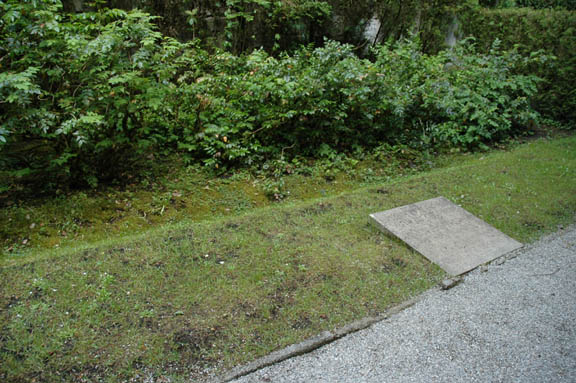 The photo above shows a stone which marks the execution spot in the woods behind the crematorium at Dachau where the four British SOE agents were allegedly shot. In front of the shrubbery is the "blood ditch" which was designed to catch the blood after a prisoner was shot in the neck from behind. On March 1, 2006, a non-fiction book about Noor Inayat Khan by Shrabani Basu, entitled "The Spy Princess," was published; the date of Noor's alleged execution at Dachau is given as September 13, 1944, the date that is in the files of the British Public Record Office. The discrepancy in the date of the alleged execution is due to the fact that there are no official records whatsoever of the execution of any female British SOE agents. There is more evidence that Elvis is still alive than there is evidence that these four women were executed at Dachau. In answer to an e-mail query, I received a response from Albert Knoll, a staff member at the Dachau Memorial Site, in which he said that any documents about the execution of the four SOE agents in the Dachau concentration camp, if they ever existed, had been destroyed by the SS shortly before the liberation of the camp. Arthur Haulot, a former Belgian prisoner at Dachau and one of the prominent members of the CID, told Sarah Helm, the author of a biography of SOE officer Vera Atkins, entitled "A Life in Secrets," that he had never heard any mention of these women while he was in the camp. Haulot was having an affair with a German nurse in the camp, according to his Diary, and he was in a unique position to know what was going on. According to Sarah Helm's book, "No witnesses had been interrogated who had seen anything at all of these women inside Dachau concentration camp." There is nothing about the "brutal murder" of these four SOE women in the trial transcripts of the American Military Tribunal at Dachau because no member of the camp staff was ever charged with this crime. The man in charge of executions at Dachau, Wilhelm Ruppert, was charged with a war crime by the Tribunal for carrying out executions ordered by the Reich Security Home Office (RSHA) in Berlin, but at the time of his trial in November 1945, the Allies knew nothing about the "brutal murder" of these four female spies at Dachau, because no documents about their execution were ever found.
 In 1975, a similar plaque was hung in the crematorium at the former Natzweiler concentration camp in Alsace where four other women SOE agents were allegedly killed by lethal injection on July 6, 1944 and their bodies were burned in the one crematory oven. Their names are Vera Leigh, Diana Rowden, Andrée Borrel and Sonia Olschanezky. Legend has it that Andrée Borrel was burned alive, although according to hearsay testimony given in a British Military Court, she fought heroically and scratched the face of her executioner, scarring him for life. The Special Operations Executive (SOE) was a secret British organization started by Winston Churchill and Hugh Dalton in July 1940, shortly after France signed an Armistice with Germany. Its purpose was to aid partisans and resistance fighters in France and other conquered countries that were occupied by Germany during World War II. Also called Churchill's Secret Army, its directive was to "set Europe ablaze." The largest group of spies in the SOE was the F section which operated in France; it was headed by Major Maurice Buckmaster. The majority of the women agents were in the French section, including the four agents who were allegedly killed at Dachau. Noor Inayat Khan was a wireless operator for the Cinema sub circuit of the Physician Network, headed by Francis Suttill, whose code name was Prosper. She was flown to France on a RAF Lysander plane on the night of June 16, 1943 and was captured on or around October 1, 1943. Eliane Plewman was a courier for the Monk Network, headed by Charles Stepper. She parachuted into France on August 13, 1943 and was captured in March 1944. Yolanda Beekman was a wireless operator for the Musician Network. She left England in an RAF Lysander plane on September 18, 1943 and was captured on January 12, 1944. Madeleine Damerment was sent to be a courier for the Bricklayer Network. She parachuted into France on the night of February 28, 1944 and was arrested by the Gestapo the moment that she landed. To the British, the SOE agents were heroes who helped to liberate Europe from Fascism by means of espionage and sabotage, but to the Germans the SOE agents were "terrorists," operating illegally to help the French resistance "bandits" to destroy factories, blow up troop trains and worst of all, to delay German Panzer divisions from reaching Normandy until it was too late to stop the Allied invasion of Europe. The SOE supplied arms, money and food for the insurgents fighting the Nazis. It was a secret organization because it was against international law to provide military aid to countries that had laid down their arms and signed an Armistice, promising to stop fighting. Women were not recruited for the British SOE until April 1942, according to Sarah Helm's book entitled "A Life in Secrets." The problem was that the statutes of the British Army, Navy and Royal Air Force barred women from armed combat, so there was no legal authority for women to engage in guerrilla warfare. As insurgents, operating behind enemy lines in civilian clothing, the SOE agents did not have the same protection as POWs under international law. If caught, they could be legally executed as spies. Women were especially vulnerable because the 1929 Geneva Convention and the 1907 Hague Convention on Land Warfare made no provision at all for protecting women, as women were not envisioned as combatants. To get around the rules, the women agents were commissioned in a civilian organization called the First Aid Nursing Yeomanry (FANY) during the time they were operating as guerrilla fighters. Churchill himself secretly approved the deployment of women as SOE agents. The British military did not want women in the SOE working as spies, but the senior officers in the SOE thought that women would be ideally suited to be couriers since they could move about freely without creating suspicion. According to Sarah Helm's book, "If the use of women as guerrillas leaked out, the policy would have to be denied." As soon as France was liberated in August 1944, Buckmaster's assistant, Vera Atkins, took it upon herself to find out what had happened to the missing agents whom she had supervised as they prepared to drop by parachute, or land in a small plane, in enemy territory. According to Sarah Helm's book, Atkins encountered resistance from the SOE: Atkins wanted to circulate the names of the missing agents widely so that, when the concentration camps were liberated, they would be found. But according to Sarah Helm's book, "On sight of Vera's memo, John Senter, head of SOE's security directorate, commissioned as a commander in the Royal Navy Volunteer Reserve, immediately pulled rank, saying her search should, in effect, be stopped." Circulating the names of the missing women would have revealed to the enemy that secret missions had taken place and that rules had been broken to carry out these missions. Irregular combatants in civilian clothes, which was what the women SOE agents were, did not have protection under the Geneva Convention. After the war, the SOE was disbanded but Vera Atkins secured a commission as a flight officer in the WAAF, the Women's Auxiliary Air Force, which allowed her to continue her work in searching for the missing agents. If she had not volunteered to look for the missing SOE agents, their files would have been closed and marked "missing and presumed dead," when the SOE ceased to exist in 1946. The names of the women in the SOE were not publicly known until long after the war. In 1948, the names of Yolande Beekman, Madeleine Damerment and Eliane Plewman were revealed for the first time when they were included among the 52 women honored by a plaque placed at St. Paul's Church, Knightsbridge. The name of Noor Inayat Khan was not publicly known until 1949 when she was awarded the George Cross. For years, the British kept the very existence of the SOE secret. By 1946, the SOE had closed down and all of its files were sealed. A mysterious fire in 1946 had destroyed many of the files. The surviving agents were instructed never to talk about their war-time experiences. The files of the SOE were kept secret from the public until 1998 when some of the documents were finally released. More of the files were opened to the public between 2003 and 2006. The file on the "brutal murder" of the four women at Dachau was released to the public in 2003, and since then, no effort has been spared by the British to make these agents, especially Noor Inayat Khan, into the greatest heroes of World War II. I sent an e-mail query to the office where the Public Record Office files are kept and received a response from Dr. Graham Macklin. According to Dr. Graham Macklin, there is no documentation whatsoever in the British SOE files on the alleged executions of women agents at Natzweiler and Dachau. All of the information about the executions came from interviews done during various investigations. Dr. Macklin stated the following in his e-mail to me: According to the 'Report on the killing of seven British officers, French section M.O.I (S.P) in Germany 1944 (Karlsruhe Gestapo)' in WO 311/293, a post-war SOE investigation into these murders conclusively established that 'the victims had been held for sometime at Karlsruhe' prior to their murder in Dachau and Natzweiler. Nor does this information appear to rest solely on the testimony of Kriminalsekretaer Christian Ott. The various depositions within this file indicate that the information that these women were executed in Dachau and Natzweiler was based on a widespread investigation drawn from a variety of sources. Note that Dr. Macklin refers to the report of "seven British officers" in the French section who were held by the Karlsruhe Gestapo, not eight. The eighth woman was Noor Inayat Khan, alias Nora Baker, who was held as a Nacht und Nebel prisoner at Pforzheim prison, 15 miles from Karlsruhe, because she had made two escape attempts. She was kept in chains most of the time and not allowed to communicate with anyone in the outside world. There is no record of her being brought to the Karlsruhe prison, from where Gestapo agents Christian Ott and Max Wassmer allegedly escorted four women to Dachau to be executed. Much of the information about the deaths of the women came from Christian Ott, who was imprisoned by the Allies at Dachau after the war as a possible war criminal. When Dachau was liberated on April 29, 1945, there were at least six male British SOE agents among the prisoners including Johnny Hopper, Robert Sheppard, Brian Stonehouse and Albert Guérisse. After surviving Mauthausen and Natzweiler, two concentration camps that were much worse than Dachau, they had been brought to Dachau on September 6, 1944, less than a week before the women were allegedly executed. Madeleine Damerment had previously worked for two years with the PAT line which Albert Guérisse headed before he was captured. Later, she was assigned to be a courier for the Bricklayer line, but was captured by the Gestapo on the same day that she parachuted into France. On the day that Dachau was liberated, there was one American in the camp, Lt. Rene Guiraud, a spy in the OSS, the US military intelligence organization. Rene Guiraud had been parachuted into Nazi-occupied France, along with a radio operator. His mission was to collect intelligence, harass German military units and occupation forces, sabotage critical war material facilities, and carry on other resistance activities. Guiraud organized 1500 guerrilla fighters and developed intelligence networks in Europe. During all this, Guiraud posed as a French citizen, wearing civilian clothing, which means that if he were caught, he would not be protected under the 1929 Geneva Convention. Guiraud was captured in France and interrogated for two months by the Gestapo, then sent to Dachau in September 1944, around the same time that the women were executed. The work done by Albert Guérisse and Rene Guiraud for the French Resistance was far more important than anything that the women agents had ever done. Yet, Madeleine Damerment was executed, after being captured on the day that she landed in France, while Guérisse and Guiraud were allowed to live. There were no male SOE agents executed at Dachau; on the contrary, the male British SOE prisoners were treated exceptionally well there. They did not have to work in the factories, nor on the farm at Dachau, but were instead given easy jobs inside the camp. Albert Guérisse worked in the infirmary at Dachau, just as he had at Natzweiler. This gave him the opportunity to conspire with other Communist prisoners who worked in the infirmary in organizing a prisoner's committee which eventually took over the Dachau camp the day before it was liberated. Brian Stonehouse, who later became an illustrator for Vogue magazine in civilian life, attributed his survival to the fact that the Nazis kept him alive for four and a half years in order to make use of his ability as an artist. By some remarkable coincidence, Guérisse and Stonehouse had been sent to the Natzweiler camp shortly before four female SOE agents were executed there, and were then transferred to Dachau just days before four more female SOE agents were brought there to be executed. Although there was a typhus epidemic at Dachau and all the prisoners were told that they had to remain inside the camp for several weeks, Stonehouse and Guérisse left for London a few days later. They were welcomed home by Vera Atkins, who had already started a search to find the missing agents that had been captured by the Gestapo. At that point, Atkins knew nothing about the alleged execution at Dachau, so she didn't ask about it and neither Guérisse nor Stonehouse mentioned it. Nor did Stonehouse and Guérisse say anything about witnessing the arrival of four women SOE agents at Natzweiler, which Atkins was already actively investigating. According to Sarah Helm's biography of Vera Atkins, entitled "A Life in Secrets," Atkins went to the Karlsruhe prison on April 27, 1946 to examine the records of the SOE agents who had been imprisoned there for nine months before they were taken on July 6, 1944 to "einem KZ," meaning an unnamed concentration camp. Atkins did not find Noor's name, nor her alias Nora Baker, in the Karlsruhe records, but when she discovered that "Sonia Olschanezky" was one of the women who had left on July 6, 1944, Atkins assumed that Noor had used a new alias, just as Madeleine Damerment had given the alias "Martine Dussautoy" at the prison. She was now positive that Noor Inayat Khan was one of the women who had left Karlsruhe on July 6th, bound for an unnamed concentration camp, which Atkins was sure was Natzweiler. At that point, Atkins had no idea that Noor Inayat Khan had been a prisoner at Pforzheim, not Karlsruhe. Noor was the first captured SOE agent to be sent to a prison in Germany. The British Military Court proceedings against Dr. Werner Röhde and 8 other members of the Natzweiler camp, for the murder of four SOE agents at Natzweiler, began at Wuppertal on May 29, 1946. Vera Atkins was the first witness for the prosecution. According to the original trial transcript, Vera Atkins testified that Noor Inayat Khan had been murdered at Natzweiler. The trial transcript was altered in 1947 when new information indicated that Noor was still a prisoner at Pforzheim as late as September 1944, according to Sarah Helm's book. The altered transcript of the trial, published in 1949, said that the fourth woman was "unidentified." In the Karlsruhe records of Madeleine Damerment (alias Martine Dussautoy), Eliane Plewman and Yolande Beekman, all of whom had left the prison on September 11, 1944, there was no indication of where they had gone. Until her trip to Karlsruhe, Atkins had assumed that Yolande Beekman was one of the women executed at Natzweiler on July 6, 1944, based on a sketch done by Brian Stonehouse, an SOE agent who had witnessed the arrival of the women at the camp. With only 4 weeks remaining until the trial of nine staff members at Natzweiler for the murder of four SOE agents, their names were not yet known, since there was no documentation whatsoever of their deaths. Sarah Helm wrote the following with regard to the Karlsruhe records for Martine Dussautoy, Eliane Plewman and Yolande Beekman: Under "taken to" it said "abgeholt nach": no destination. Under another entry was written "Fr Fuss," meaning literally that they went "freely on foot," or were set free. Much of the information about the execution of four women at Dachau comes from a statement made by Christian Ott, who told American interrogators that he had accompanied four women from Karlsruhe to Dachau on September 11, 1944, but he couldn't remember their names. Max Wassmer, another Gestapo man at Karlsruhe, was in charge of the trip; he couldn't recall the names, nor even the number of women that he had escorted to Dachau. Sarah Helm wrote the following about Ott's statement to the interrogators: Waiting on the station platform, Ott expressed surprise to Wassmer that women were being sent to Dachau. He understood that Dachau was a camp for men only. He asked Wassmer "several times" whether Dachau was now taking women. "Wassmer, at last tired of my repeated question, showed me a telegram from the Reich Security Head Office (RSHA), Berlin, and told me to read it." The telegram Ott read said the women were to be "executed at Dachau" and was signed by Ernst Kaltenbrunner, head of the RSHA. Ott said he recalled that Wassmer had told him "this must be an important case since the telegram had been signed personally by 'Ernst' - that is to say, Dr. Kaltenbrunner. 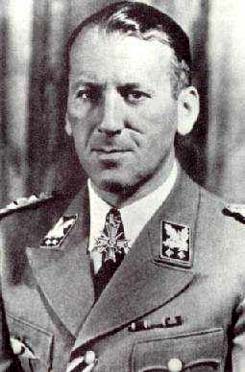 Ernst Kaltenbrunner was one of the top Nazi leaders, important enough to have been included among the accused in the first proceedings of the Nuremberg International Tribunal which began in November 1945. At the Nuremberg IMT, Kaltenbrunner was charged with being responsible for the genocide of the Jews. Kaltenbrunner's position was higher than that of Reichsführer-SS Heinrich Himmler, the all-powerful head of the SS and the concentration camps. All punishments in all the concentration camps had to be approved by the head office of the SS in Oranienburg and all punishments of female prisoners, including executions, had to be approved by Himmler himself. As Chief of the Security Police, Kaltenbrunner was the head of the RSHA and the regional offices of the Gestapo, SD and Kripo. Kaltenbrunner received orders directly from Hitler, which means that these female British spies might have been secretly executed on the orders of Hitler himself. This could explain why Kaltenbrunner had pulled rank on Himmler and ordered the execution of the women without Himmler's knowledge. An Austrian, from the same area as Hitler, Kaltenbrunner was a sinister-looking man whose face was marred by a deep dueling scar on his cheek. He was perfect for the role of the villain in this story. He was also dead, having been executed on October 16, 1946 after being convicted of Crimes against Peace and Crimes against Humanity. One of the women allegedly executed at Dachau was Madeleine Damerment, alias Martine Dussautoy, an innocent low-level courier who had never had the opportunity to "set Europe ablaze" because she was arrested by the Gestapo the moment she touched the ground after parachuting into France. The plans for her drop had been made by the Gestapo using the radio of Noor Inayat Khan, who had already been captured. According to Christian Ott's hearsay statement, Ernst Kaltenbrunner had taken time out from running the RSHA to personally send a telegram to Karlsruhe prison, ordering Madeleine Damerment and 3 other women to be transported to Dachau, a men's camp, to be secretly executed. Of course, the incriminating telegram was never found. According to the biography of Vera Atkins, written by Sarah Helm, Vera had learned in the course of her investigation that RSHA's policy was that Any orders concerning spies came from the desk in Berlin of a man named Horst Kopkow. It was Kopkow, Vera learned, who ordered every Sonder Behandlung, or "special treatment," and who signed every protective custody order used for spies. Kopkow was fastidious and always required "receipts" for bodies when executions had taken place, except when the cases were N+N, in which case special secret procedures were enforced. N.N. is an abbreviation for Nacht und Nebel, a special classification for prisoners who were made to disappear into the night and fog, as an alternative to being executed. They were not allowed to send or receive letters; their families were not told where they were and they assumed that their relative had been executed. Of the four women executed at Dachau, only Noor Inayat Khan was an N.N. prisoner. She was given this designation after her two escape attempts. Sonder Behandlung (special treatment) was the Nazi code word for murder, specifically the murder of the Jews in the gas chamber. 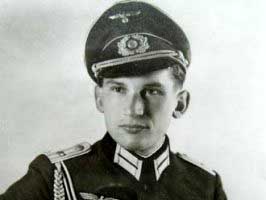 Horst Kopkow was never put on trial for ordering the execution of approximately 300 spies. He was arrested as a war criminal after the war, but he cooperated with the British, giving them a wealth of information about the German intelligence service. In 1948, he was recruited by the British to work as a spy in the Cold War against the Soviet Union. According to Christian Ott's statement to interrogators, Madeleine Damerment spoke "gut Deutsch," making her a prime candidate to be recruited as a double agent. By her own admission, according to Ott, Madeleine had gained 30 pounds during her 9 months of imprisonment at Karlsruhe. Was the Gestapo plying her with Apfel Strudel in an effort to get her to work for them? There are numerous references in Sarah Helm's book to British SOE agents who turned against their country and became double agents, after finding out that they had been betrayed by the SOE. A few days after Dachau was liberated on April 29, 1945, the US Seventh Army issued an Official Report which summarized the events that had transpired at Dachau, based on what they had been told by 20 inmates. Their main informant was Albert Guérisse, who immediately took the Americans on a tour of the camp and showed them the gas chamber. The Americans were apparently not told about the execution of General Charles Delestraint, a prominent member of the French Resistance, nor were they told about the "brutal murder" of the four British SOE women since the Army report did not mention it. However, the Report did state that Johann Kick, the head of the Political Department, was given a new position in August 1944 in which he was put in charge of STAPO Aussenstelle Dachau. In Appendix A of the report, the following is stated: "In his new position Kick was charged with recruiting espionage agents from the Dachau Concentration Camp. He relied almost wholly on intimidating and coercive methods." Could the four British spies have been brought to Dachau in an effort to recruit them as double agents? Johann Kick testified at the American Military Tribunal at Dachau that it was the responsibility of the Political Department at the camp to notify the RSHA office in Berlin after an execution. No such report about the execution of the women SOE agents at Dachau was ever found, nor was the order for the execution of four women SOE agents at Dachau ever found. In her book "A Life in Secrets," Sarah Helm wrote that Ott said the train arrived at about ten p.m. in Dachau. Wassmer's version of the story was that the train arrived at midnight. After handing the four women over to "camp officials," that was the last that Ott ever saw of the women. Ott slept that night in the building above the gate at Dachau. The next morning, Ott said that Wassmer told him that the women were scheduled to be shot at 9 a.m. Wassmer himself read the death sentence to them. Besides Wassmer, only the camp Commandant and the two SS men who fired the shots were present at the execution, according to Ott's hearsay statement. According to Sarah Helm's book, Wassmer denied that he had told Ott that he had been present when the women were executed. Wassmer told Vera Atkins that he had delivered the women to the SS guards at Dachau and had not seen them again. All of the German war criminals were prosecuted by the Allies on charges of "participating in a common design to violate the Laws and Usages of War under the 1929 Geneva Convention and the 1907 Hague Convention" which meant that Wassmer would have been guilty of a crime if he had, in fact, witnessed the execution of the women at Dachau. According to the prosecutors at the American Military Tribunal, held at Dachau, any SS man or prisoner who witnessed an execution ordered by RSHA, and did not try to stop it, was guilty of murder. At the time that Vera Atkins first interrogated Max Wassmer, she believed that there were three women brought to Dachau for execution, and Wassmer was willing to agree that there were probably only three, not four, as Ott had claimed. Wassmer said that he was told the next morning that the women had been shot and he was given a "receipt" for the bodies. Apparently the receipt disappeared into the same black hole as the telegram from Ernst Kaltenbrunner, so the number of bodies could not be verified. Six months later, Vera Atkins interrogated Max Wassmer again; by this time she suspected that Noor Inayat Khan had been brought from Pforzheim prison to Karlsruhe where she joined the other three women on the trip to Dachau. This time Wassmer gave the answer that she wanted: there were four women taken to Dachau, not three, as he had previously said. After the typhus epidemic at Dachau was brought under control, the camp was used to house accused German war criminals. The former Dachau inmates and the German war criminals were both interrogated in preparation for the first American Military Tribunal at Dachau, which started in November 1945, but the interrogators apparently never learned about the execution of the women SOE agents, even though Christian Ott was one of the prisoners at Dachau at that time. The 225-page Public Records Office file on Noor Inayat Khan was released to the public in 2003. It contains the statement of an unidentified Dutch prisoner at Dachau, known only by his initials A.F., who claimed to be an eye-witness to her execution. The spot where the four women were allegedly executed was located in a wooded area outside the camp and hidden from view by shrubs and trees, as shown in the photo below.  On May 13, 2006, Alan Hamilton wrote an article, published on the British web site www.timesonline.co.uk, which gave the details of the Dutch prisoner's eye-witness testimony, as quoted below: In 1958, a former Dutch prisoner of the Nazis known as "A.F." who witnessed Noor's execution read her biography and wrote to its author, Jean Overton Fuller. He revealed her killer to be Wilhelm Ruppert, a sadistic SS guard at the camp, and he described Noor's last moments on September 12, 1944. "The SS undressed the girl and she was terribly beaten by Ruppert all over her body. She did not cry, neither said anything. When Ruppert got tired and the girl was a bloody mess he told her then he would shoot her. She had to kneel and the only word she said, before Ruppert shot her from behind through the head, was 'Liberté'." She was 30 years old. Other accounts of Noor's alleged execution say that she was shot inside one of the cells in the bunker (camp prison) at Dachau, although two British prisoners in the bunker never reported hearing the shot. 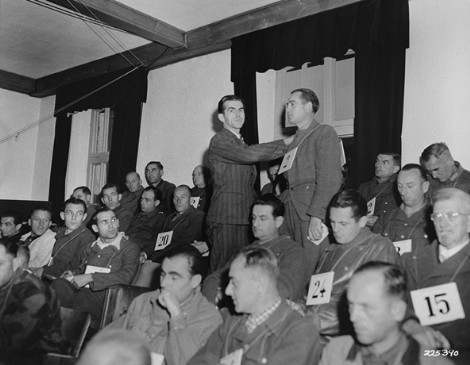 Whether or not he was "sadistic," Wilhelm Ruppert was higher in rank than a lowly guard at Dachau. If the SOE women were executed at Dachau, he would not have been the one who did the shooting. At the American Military Tribunal held at the former Dachau concentration camp in November 1945, Ruppert was considered the second man in importance after the former Commandant, Martin Gottfried Weiss. In the photo above, Ruppert is standing on the right and Weiss is sitting in the aisle seat just below him. At the trial of the Dachau concentration camp staff members, Ruppert was specifically charged with carrying out Hitler's order for the execution of 90 Russian officers, who were Communist Commissars, on September 4, 1944, the week before the alleged execution of the British SOE women at Dachau. No attempt was made to conceal the execution of the Russian officers. Ruppert's defense, that he was carrying out superior orders and that the Soviet Union had not signed the 1929 Geneva Convention, did not save him from being hanged as a war criminal. Ruppert did not do the actual killing of the Russian officers. His job was to see that executions, ordered by RSHA, were carried out, although according to Christian Ott's hearsay version of Max Wassmer's story, Ruppert was apparently not present when the women were executed. The two SS men who did the shooting at Dachau executions were Franz Trenkle and Theodor Bongartz. Trenkle was sentenced to death by the American Military Tribunal at Dachau; he was executed on May 28, 1946. Bongartz died in captivity soon after he was captured in 1945. Ruppert was hanged on May 28, 1946, the day before Vera Atkins testified at the Natzweiler trial that Noor Inayat Khan had been killed at Natzweiler. Ruppert had not been charged with beating and then shooting Noor Inayat Khan because the Dutch prisoner at Dachau, who claimed to have witnessed her execution, did not come forward with his story until 1958, and even then, he chose to share this information with a writer, not with the Nazi hunters who were still looking for war criminals to prosecute. As a witness to an execution, this Dutch prisoner was a war criminal, according to the standards of the American Military prosecutors, because he did not try to stop it; this may be why he kept quiet until 1958. Sylvester Filleböck, an SS man who was accused of witnessing an execution at Dachau, was convicted and sentenced to death, although his sentence was commuted to 10 years in prison. Even Kapos, the prisoners who assisted the camp staff, were held to be responsible for stopping executions: Emil Erwin Mahl, a Kapo who assisted at executions at Dachau, was condemned to death but his sentence was commuted to 15 years in prison. Dr. Werner Röhde was convicted and hanged on October 11, 1946 for committing war crimes, including the murder of Noor Inayat Khan and three other SOE agents at the Natzweiler concentration camp in Alsace. At the request of Vera Atkins, Dr. Röhde had signed a death certificate for Noor, thereby providing the only documentation of her death - at Natzweiler, not Dachau. In answer to my query, Dr. Graham Macklin stated in his e-mail response to me, with regard to the files in the Public Records Office, that The file also confirms that Ott, Wassmer and another man named Heuser escorted the women to the concentration camps. Christian Ott, Max Wassmer and Heuser were Gestapo agents who worked at Karlsruhe where seven of the women were imprisoned before they were allegedly taken to Natzweiler and Dachau for execution. It was their job to escort prisoners when they were moved to a new location, but according to Albert Knoll, who works in the Dachau Archives, the names of Max Wassmer and Christian Ott, the two Gestapo agents who allegedly accompanied the women to Dachau, are not listed in the Archives although they supposedly stayed overnight at the Dachau camp. Knoll wrote, in answer to my questions, that all the executions of Dachau prisoners had been public and that the other prisoners had been forced to be eye-witnesses, since this was a measure of deterrence. But all the executions of Prisoners of War, secret agents, members of the Resistance and prominent prisoners had been strictly secret. Executions of non-Jewish women had always been a source of embarrassment for the male perpetrators, according to Knoll. Regarding the trip from Karlsruhe prison to Dachau, the following quote is from the book "Flames in the Field" by Rita Kramer: Wassmer later described the September trip to Dachau for the English writer who was so interested. They had gone by express train and he told her he had given the four women the window seats. They had passed around some English cigarettes one of them still had in her possession and he had given them some of his German ones when they ran out. Their conversation was lively; he didn't think they were frightened, but of course he didn't understand what they were saying. They spoke English. They got to Dachau around midnight [...] The four walked up the hill from the station to the camp, where they were locked up separately overnight, and in the early morning they were taken to a spot strewn with sand stained with blood and told to kneel down there. They knelt in pairs, holding hands, as an SS man came up and shot them from behind. I once spent a week in the town of Dachau and I walked the route from the train station to the camp. There is no hill between the station and the camp, although there is a hill with a castle on top of it in the town of Dachau. Even in the dark, Wassmer should have known whether or not he was walking uphill. When Christian Ott was interrogated by Alexander Nicholson, the war crimes investigator who had taken over the Karlsruhe Gestapo case from Vera Atkins, he told him about a conversation that he had had with Wassmer after the women were allegedly shot. As described by Sarah Helm in her book, the conversation went like this: Ott told Nicholson: "So I said to him, 'But tell me, what really happened?' And Wassmer turned to me and said: 'So you want to know how it really happened?' " Nicholson asked what Ott had taken Wassmer to mean by this comment. "I knew what he meant was that what he had told me was just a story - eine Geschichte - that he had made up, and I wouldn't want to know what really happened." Christian Ott and Max Wassmer were both in their late fifties and probably worried about spending the rest of their lives in prison as war criminals. Both were great story tellers, adding rich detail to their accounts, and they were both willing to say anything to please their captors, as long as they didn't incriminate themselves. Wassmer and Ott told their interrogators that they had also taken four SOE women to Natzweiler. Both were released from custody and were never prosecuted, although they were just as guilty as Franz Berg, the Natzweiler inmate who was sentenced to 5 years in prison for building the fire in the crematory oven at Natzweiler where the bodies of four SOE women were allegedly burned. Noor Inayat KhanBritish SOE agents executed at NatzweilerBack to Table of ContentsHomeThis page was last updated on March 26, 2008 |
